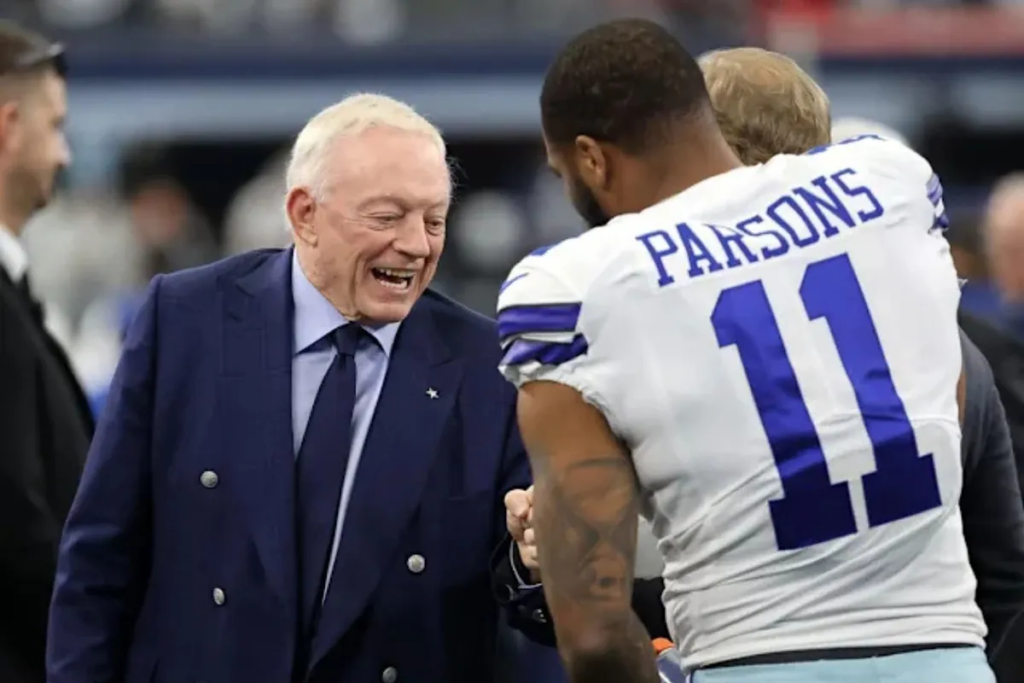In a move that stunned the NFL world, the Dallas Cowboys traded linebacker Micah Parsons to the Green Bay Packers shortly before the 2025 season-an exit that now raises pointed questions about salary cap handling under owner-general manager Jerry Jones.
Sources suggest the Cowboys’ decision was driven not just by contract disagreements but by a deeper, systemic failure to manage cap space effectively.
Dallas had already invested heavily in star players like Dak Prescott and CeeDee Lamb, resulting in financial inflexibility.
With Parsons commanding top-tier money, the team found itself squeezed-and without a solution to keep its premier defender, according to NFL sportscaster Mike Tirico.
“You can say the Cowboys have not been as pinpoint, ahead of the game, as the other successful franchises in managing the cap when it comes to big-ticket items. When you sit in the chair, whatever Jerry’s chair is… you have to think of the future. This trade does have some future thoughts in mind,” Tirico said.
“Because they were heading down a road where, Dak Prescott, number-1 paid player in average annual value, at $60 million a year. CeeDee Lamb, third among wide receivers only behind Jamar Chase and Justin Jefferson, and then Micah would have been at the top of the market for defensive players.
“So you can’t field another 50 (players) when your three are gaining 40, 42, 46, maybe even 50 percent of the cap.”
A costly cap strategy
Reports indicate that Parsons, seeking a historic deal, found his payback request met with resistance not because it was unreasonable, but because the Cowboys simply lacked the room. The team had a relatively modest $31 million in cap space, far short of the flexibility needed to keep Parsons and still retain key pieces.
Meanwhile, some corners of the analytics world questioned Jerry Jones’ dual role. The blending of ownership and GM responsibilities may have clouded judgment-and delayed decisive action until the situation became unavoidable.
With cap strain mounting, Dallas opted to trade; in return they received defensive tackle Kenny Clark and two future first-round picks-a move seen as both a desperation measure and a cost-saving play.
Now, critics paint the trade as driven less by strategic vision and more by financial necessity. ESPN analyst Dan Orlovsky called it “one of the worst trades in franchise history,” arguing that Parsons was a generational talent and that draft picks-likely late first-rounders-offer much less value.
Many fans and pundits now wonder whether better cap planning earlier could have spared the organization the fallout.
There’s also the emotional dimension. Parsons didn’t learn of the trade directly from leadership; instead, he heard through his agent, suggesting that mismanagement wasn’t limited to dollars-but also communication and trust.
Green Bay’s gain, Dallas’ gamble
In Green Bay, Parsons inked a four-year, $188 million deal-catapulting him to the highest-paid non-quarterback in NFL history, complete with $120 million guaranteed. It’s the kind of vision and commitment Dallas couldn’t match-at least not without sacrificing other cornerstones.
The trade’s aftermath highlights a bitter irony: cap space meant to keep the team competitive instead contributed to dismantling the defensive core.
But there is another side. The franchise acting swiftly to address mounting pressure and reallocate resources could pay dividends if those draft picks produce and Parsons reshapes the run defense.
Only time will tell whether this decision looks like short-term desperation or long-term gain.
Jerry Jones has defended the move, likening it to the legendary Walker trade that ultimately helped build championship teams. He insists the Cowboys received what they needed. But the optics suggest something more troubling: that mismanagement-not miracles-often shape outcomes in today’s NFL.
Read the full article here

